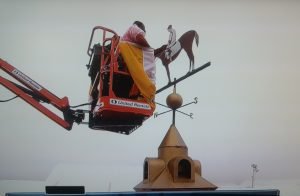How To Justify Tradition

I am not a horse racing enthusiast, rather an interested observer. Don’t get me wrong, I do like a good race. The Triple Crown races, the Kentucky Derby, the Preakness and the Belmont Stakes do attract my attention. Each of them is steeped in their own traditions.
Kentucky Derby
The Kentucky Derby, known as the “Run for the roses,” is held on the first Saturday in May. The event has developed a tradition for attendees in big hats, consumption of mint julips, pari-mutuel wagering and the singing of “My Old Kentucky Home.”
Preakness
The winner of the Preakness is draped in a blanket of Black-Eyed Susans. The black and yellow colors of the flowers are also the state colors and the color theme for the Preakness every year. While watching the race won by “Justify” last weekend, I discovered another cool tradition, which actually began in 1909.
As soon as the Preakness winner has been declared official, a painter is lifted up to the top of the replica Old Clubhouse copula in the winner’s circle to paint the weather vane. The colors of the winner’s silks and the horse’s color are applied to the jockey and horse on the weather vane, and it remains that way until the next year’s Preakness winner is crowned.
THAT is a justifiable tradition!
Belmont Stakes
The final leg of the Triple Crown has a few of its own traditions. The race is traditionally called “The Test of The Champion” or “Run for the Carnations” because the winning horse is blanketed with white carnations.

